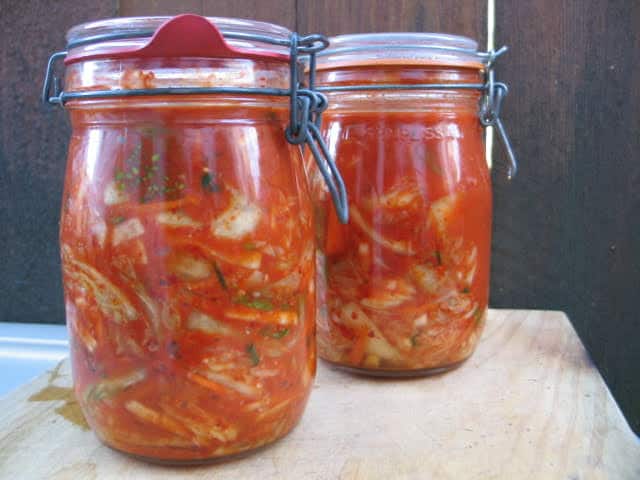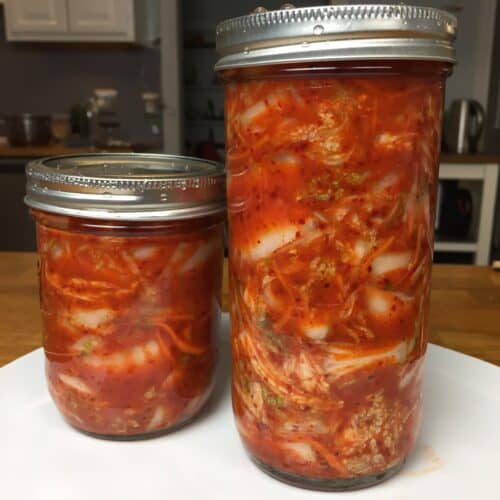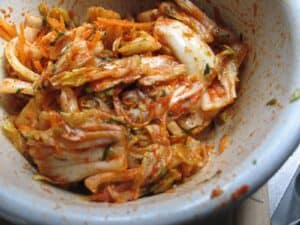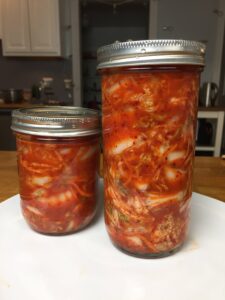
I’ve been making kimchi for years — it’s one of my favorite fermented foods. What is kimchi? It’s a traditional Korean side dish made from salted and fermented vegetables, most often Napa cabbage or daikon (a type of giant radish) seasoned with lots of garlic and chili powder, ginger and green onions. Kimchi can be consumed as an accompaniment to foods, or used to spice up soups, stews, or even grilled cheese sandwiches.
To keep things simple for those just starting out, this recipe is for a small batch, just one quart, so you shouldn’t need any special equipment. Also, the end product will just be one or two canning jars worth, so it won’t take up too much space in your refrigerator.
My recipe is based on the queen of Korean cookery, Maangchi’s. I have made some tweaks to her recipe through the years — just based on my personal taste, and in terms of what I can do in my kitchen. You’re also welcome to tweak my recipe, adjusting the amount of heat, for example, or using whatever cabbage may be be growing or available in your area.
So get yourself a Napa cabbage or equivalent and let’s start fermenting!

Small Batch Kimchi
Equipment
- 2 Canning jars
Ingredients
Vegetables
- 1 head Napa cabbage cut into pieces, soaked in salt overnight, drained
- 1 carrot medium, peeled and julienned
- 1/2 cup salt Kosher
Rice Paste
- ½ cup water 118mL
- 1 ½ tablespoons glutinous rice flour or mochiko 14g
- 1 tablespoon sugar 13g
Love Sauce
- 2 stalks of green onion thinly sliced, green part only
- 5 cloves garlic peeled, grated or pressed
- 1 yellow onion small, grated
- ½ pear ripe, peeled and grated
- 3 tbsp fish sauce
- 1 tbsp ginger fresh, grated
- ½ tsp kosher salt
- 1/2 cup red pepper flakes Korean style
Instructions
Preparing the Vegetables
- Rinse one Napa cabbage, cut it in half, and remove the core.
- Halve each half to quarter the cabbage, then cut your quarters into two-inch pieces.
- Add the cabbage to a large basin, bowl, or pot with the carrot.
- Sprinkle with kosher salt and follow with enough water to cover the vegetables.
- Soak for an hour and a half to two hours to give the saltwater time to penetrate the vegetables.
Preparing the Paste
- Meanwhile, pour water for the paste into a saucepan, followed by the glutinous rice flour. Whisk together to break up any lumps before turning on the heat.
- Turn the heat to medium and cook while stirring until thickened. Keep it moving to prevent the paste from burning.
- Add the sugar towards the end when the paste starts to thicken. The entire process should take about 5 minutes.
Preparing the Love Sauce
- First, combine the green onion, garlic, yellow onion, pear, gochugaru, fish sauce, ginger, and salt with the rice paste once it has cooled.
- Mix until well incorporated.
Adding the Vegetables to the Paste
- Once the vegetables have soaked for the required amount of time, drain them, returning them to the basin you soaked them in.

- Using food-safe gloves, massage the paste into the cabbage and carrots. Even go so far as squeezing the mixture to incorporate all that paste.
Canning the Kimchi
- Tightly pack the kimchi into nonreactive containers. (For this recipe I used one quart and one pint sized canning jar.)

- Put the lids and the canning rings on top and turn them slightly. Do not tighten as the kimchi will bubble and create gas as it ferments, so it needs a way to escape
- Leave to sit at room temperature for 24 to 48 hours — by then, the kimchi will be nice and tangy.
Emmy,
Is it okay to use regular cabbage I’ve grown in my garden and will this alter the taste?
Thanks,
Terry
You’re welcome! 🙌🏻
I like the Napa for the texture. The taste may be different too. You could try and let me know?
So good!
I’m constantly looking for recipes to serve just 1 or 2 people & was delighted to finally find a small batch kimchi recipe such as yours. But I’m curious as to what size jar(s) you used for your recipe?
The picture looks like you used a quart sized jar & a pint sized jar? I want to make sure I get the right size jar(s). Thanks much for info!
Great question, Aly! I should have been more specific in the post. But yes, a 32 oz + 16 oz jar would work. Or if you only have something bigger or smaller, use whatever adds up to 48 oz and you should be good. Hope that helps!
/Why are the proportions here different from in the video? Which one should I follow?
Oh no! Let me check. It may be that I copied my original recipe onto the website, but tweaked it for the video. But you’re right, they should match. So I’d follow the video. Meanwhile I’ll update the recipe here. Thanks for pointing that out!